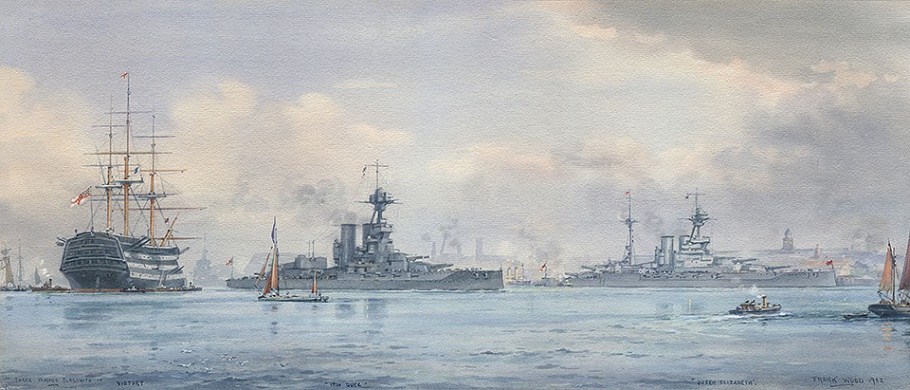THREE FAMOUS FLAGSHIPS: HM SHIPS VICTORY, IRON DUKE AND QUEEN ELIZABETH
Frank Watson Wood (1862-1953). Watercolour signed, dated 1922 and inscribed "Three Famous Flagships" and with ships names..
25.4 x 60 cms (10 x 23 1/2 ins )approx
Price is available upon request
This original has been sold and is no longer available.
Prints of this may be available on: Maritime Prints.
In 1922 when this watercolour is dated, the Commander-in-Chief Portsmouth (flag in HMS VICTORY) was Admiral The Hon Sir Somerset Gough-Calthorpe GCMG KCB CVO. VICTORY herself had recently been moved out of the stream and into Portsmouth dockyard where on 12th January 1922 she was eased into No 2 Dock, the oldest dry dock in the world dating from 1495. Here the huge task of restoration began and it could well be that Wood was responding to the renewed interest shown by the country in Nelson’s old flagship at this time by painting this watercolour.
In the centre and leaving harbour is the dreadnought battleship HMS IRON DUKE. Flagship for Admiral Jellicoe’s tenure as Commander-in-Chief of the Grand Fleet (August 1914-November 1916), IRON DUKE was, in 1922, flagship of the Mediterranean Fleet with her sisters MARLBOROUGH, BENBOW and EMPEROR of INDIA. Admiral Sir John de Robeck Bt GCB GCMG was the C-in-C and Captain M E Nasmith VC CB Flag Captain in IRON DUKE. Lt Cdr Robert Burnett, Lt Caspar John and Lt HRH Prince George were all notables in her wardroom.
HMS QUEEN ELIZABETH, to the right and alongside the dockyard wall, had been Admiral Beatty’s flagship for the last 2 years of the Great War. It had been Beatty’s good fortune to succeed Admiral Jellicoe just as our endeavours at sea were starting to bear fruit and so it was David Beatty with some 375 allied warships who took the surrender of the High Seas Fleet aboard QUEEN ELIZABETH in November 1918.
